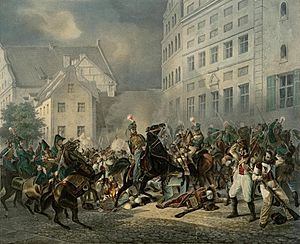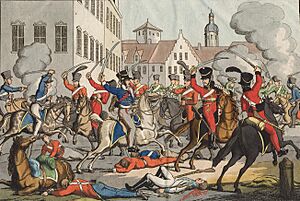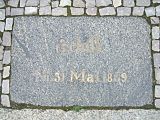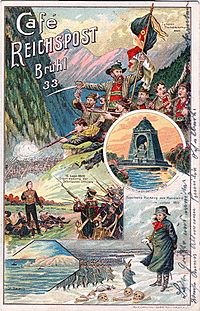Battle of Stralsund (1809) facts for kids
Quick facts for kids Battle of Stralsund |
|||||||
|---|---|---|---|---|---|---|---|
| Part of Dano-Swedish War of 1808–1809 Franco-Swedish War |
|||||||
 Schill's death at Stralsund, by Friedrich Hohe |
|||||||
|
|||||||
| Belligerents | |||||||
| Commanders and leaders | |||||||
| Strength | |||||||
| 990 Prussians 500 Swedes |
5,270 | ||||||
| Casualties and losses | |||||||
| 300–400 killed and wounded 568 captured |
241 killed and wounded | ||||||
The Battle of Stralsund happened on May 31, 1809. It was a fight during the Napoleonic Wars. This battle took place in Stralsund, a city in what was then Swedish Pomerania. It was fought between a group of Prussian volunteer soldiers, led by Ferdinand von Schill, and forces loyal to Napoleon Bonaparte. The battle was a fierce street fight. Schill's group was defeated, and Schill himself was killed.
Schill's Story: Before the Battle
Stralsund is a port city on the Baltic Sea. It was given to France after a siege in 1807. This happened during a war called the War of the Fourth Coalition.
During that war, a Prussian captain named Ferdinand von Schill became famous. He used clever tactics to cut off French supplies in 1806. In 1807, he formed his own group of volunteer soldiers, called a freikorps. He fought the French successfully. Schill hoped his actions would inspire a big uprising against the French.
After a peace treaty in 1807, Schill's group was disbanded. But Schill was promoted to major. He received a special medal called the Pour le Mérite. He became a hero for many Germans who wanted to resist French rule.
In early 1809, some German resistance groups asked Schill to lead an uprising. He agreed in April. He wrote a message to inspire people, but the French found it. Schill had to leave Berlin quickly on April 27 to avoid arrest.
Schill left with about 100 cavalry soldiers called hussars. He planned to go southwest to start a rebellion. However, he heard that the French had won a major battle. So, Schill changed his plans. He turned north, hoping to reach a port. He wanted help from the British navy.
The Battle of Stralsund
Schill and his 2,000 men entered Stralsund on May 25. A large force of about 6,000 soldiers was chasing them. These soldiers were from Denmark, Holland, and France. They caught up to Schill on May 31, inside the city.
By then, Schill had 1,490 troops in Stralsund. This included 300 Swedish soldiers from a local defense force called the landwehr. He also had 200 former Swedish soldiers, led by Friedrich Gustav von Petersson.
The Dutch soldiers, about 4,000 of them, were led by Pierre Guillaume Gratien. Another 1,500 Danish soldiers were led by General Johann von Ewald. The Dutch forces included infantry, cavalry, and artillery.
The French-led forces broke into the city through a gate called the Tribseer Tor. They fought Schill's men in the streets. Schill was killed during this street fighting. About 300 to 400 of his men also died or were wounded. Another 568 men were captured, including Petersson. Petersson was executed a few days later. About 400 to 500 of Schill's men managed to escape. The Dutch lost 173 men, and the Danes lost 68.
What Happened Next
Eleven of Schill's officers were taken to Brunswick. They were later executed in Wesel, following an order from Napoleon Bonaparte. More than 500 of Schill's other men were taken prisoner.
Schill's head was sent to The Netherlands. It was put on display in a public library. In 1837, his head was finally buried in Brunswick.
Schill was not the only one who wanted to start an uprising against the French. Other important people had similar plans. These included Frederick William, Duke of Brunswick and Kasper von Dörnberg. They all saw Austria's resistance against France as a chance. They hoped to push Napoleon out of Northern Germany. However, France proved to be too strong. Schill's defeat in Stralsund ended all plans for a large popular uprising at that time.
See also
- Pomerania during the Early Modern Age
- History of Pomerania (1806–1933)





